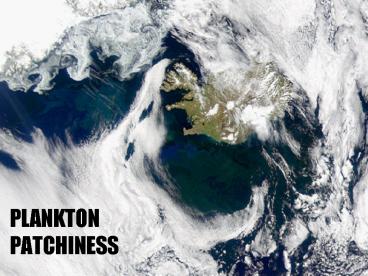PLANKTON PATCHINESS - PowerPoint PPT Presentation
Title:
PLANKTON PATCHINESS
Description:
PLANKTON PATCHINESS PLANKTON PATCHINESS Early attempts to include mesoscale forcing Fasham, 1978 white noise forcing on growth P/ t = mP + k 2P/ x2 + E(x,t ... – PowerPoint PPT presentation
Number of Views:108
Avg rating:3.0/5.0
Title: PLANKTON PATCHINESS
1
PLANKTONPATCHINESS
2
Physical processes implicated in
patchiness Diffusion-related processes Patches
Filaments Turing Mechanism Plankton
waves Lateral stirring Early observations of
phytoplankton spectra Physical
turbulence Explaining phytoplankton
spectra Zooplankton and spectra Pitfalls of
spectral analysis Biological forcing at
intermediate scales Vertical-horizontal coupling
3
(No Transcript)
4
(No Transcript)
5
(No Transcript)
6
Platt, 1972
Powell et al., 1975
7
Limited range where Chl and passive T are
correlated 10-100m to 100-1000km
K.L.Denman, 1976
8
To what extent are spectra controlled by stirring
and mixing? A theory is required to underpin the
analysis and comparison of plankton and inert
tracer spectra. Such a theory needs to relate
structure in biological fields and velocity
fields at all scales. A pre-requisite of this is
a suitable model of turbulent flow. Several
user-friendly options have been used. All rely
on cascades the conservative transfer of a
property from one scale to the next, from large
scale to small scale. Cascading properties scale
spectral density kp
9
Commonly used turbulence models
Two-dimensional turbulence
Range gt1km Cascading property enstrophy
(square of vorticity) Spectral slope -1
Three-dimensional turbulence
Range lt1km Cascading property energy Spectral
slope -5/3
10
- Motivation
- - simplest option
- cascade paradigm easy to apply to tracers
- agreement with observations
- if know what inert tracer should do, easy to
- diagnose when biology is dominant effect
- Drawbacks
- far from clear that any are accurate models
- - unlikely that cascading range exists in
practice - - forcing only at large scale
11
(No Transcript)
12
(No Transcript)
13
(No Transcript)
14
Critical scale
kc0.2-20km Physically controlled at smaller
scales Biologically controlled at larger scales
Numerous independent derivations Corrsin,
1961 Denman and Platt, 1976 Denman et al.,
1977 Powell and Okubo, 1994 Different
formulation for critical scale Fasham,
1978 kc?(m/k) KiSS scale
15
Spectra can vary with time
16
the fact that the spectra of these
two variables chlorophyll and temperature have
the same slope cannot be used to infer that the
chlorophyll distribution is controlled physically
rather than biologically.
M.J.R.Fasham (1978)
17
(No Transcript)
18
Passing just lately over this lakeI took up a
little of it in a glass phial and
examining this water next day, I found very many
little animalcules. These animalcules had
divers coloursand the motion of most of these
animalcules was so swift, and so various
upwards, downwards and round about that twas
wonderful to see. 7 September 1674
Antony von Leeuwenhoek, 1632-1723
19
(No Transcript)
20
Hardy, 1955
I once heard an eminent planktologist say
that it did not do to arrange your stations too
close together because it made it almost
impossible to use contour methods when charting
the results I dont think he realized the
significance of what he was saying.
A marked patchiness was demonstrated for all
animals occurring in sufficient numbers.
21
Mackas and Boyd, 1979
Tsuda et al., 1993
22
Theories for zooplankton having a whiter spectrum
than phytoplankton
Swarming Mackas and Boyd, 1985 Levin, 1994 -
accumulation in small groups increases
structure at small scales Non-linear
interactions Steele and Henderson, 1992
Abraham, 1998 - non-linear transfer of structure
modifies spectral slope
23
Powell and Okubo, 1994
Zooplankton and phytoplankton spectra the same.
Slope relative to passive tracer is dependent on
the turbulence model.
24
Do any generalities emerge from our studies
of the modifications that biological processes
make to the patchiness imposed by solely
physical processes?
We answer no.
one might also expect that several
biological mechanisms might lead to the same (or
very similar) spatial patterns in the plankton.
Powell and Okubo, 1994
25
Denman and Platt, 1975
26
Star and Cullen, 1981
27
(No Transcript)
28
SPECTRA ARE TOO BLUNT A TOOL
29
Majority of patchiness models assume
physical forcing of biology is restricted to
large scale. Convenient as this assumption is
common to the paradigm of cascading in the
turbulence models they use. Numerous
observations indicate that physical forcing of
biology occurs at all scales, however. - from
100km to 1km - upwelling very strong at fronts
and eddies
30
Martin, Richards and Fasham (2001)
31
clear evidence of a variance input
at wavelengths between 15 and 35km
32
Horizontal velocity
Vertical velocity
Martin and Richards (2001)
33
(No Transcript)
34
Early attempts to include mesoscale forcing
Fasham, 1978 white noise forcing on growth ?P/
?t mP k?2P/ ?x2 E(x,t) Powell and Okubo,
1994 assumed spectrum for forcing power spectra
k-1 Neither explicitly link forcing to
flow Need for explicit models(?)
35
Smith et al., 1996
Explicit biological forcing through Light -
depth of mixed layer Nutrients - mixed layer
deepening
20km resolution
36
29 inc.
208 inc.
139 inc.
37
Physical processes implicated in
patchiness Diffusion-related processes Patches
Filaments Turing Mechanism Plankton
waves Lateral stirring Early observations of
phytoplankton spectra Physical
turbulence Explaining phytoplankton
spectra Zooplankton and spectra Pitfalls of
spectral analysis Biological forcing at
intermediate scales Vertical-horizontal coupling
38
Taylor Dispersion
depth
Effective horizontal diffusivity is a function
of vertical diffusivity and shear Vertical
diffusivity is a function of stratification
KiSS length may vary with location
39
ZOOPLANKTON DIEL VERTICAL MIGRATION
Range up to 500m Rate 50-200m/day Causes pr
edator evasion, ultraviolet light evasion
40
Riley, 1976
Requires - depth-varying velocities - zoo
spend longer at depth - initial patchiness in
zoo
41
Evans, 1978
42
Rovinsky et al., 1997
43
SUMMARY
Huge range of ways stirring and mixing
can interact with biological processes to
produce plankton patchiness. Still no general,
multiscale theory of patchiness, or concensus on
whether one exists. Need for better observations
to constrain models. Need for better techniques
to analyse observations.































